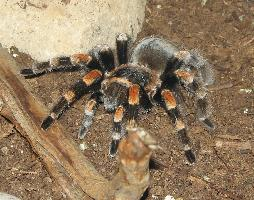
Poids et mesures
| Longueur | de 7 à 8 cm |
|---|
Données biologiques
| Durée de vie | de 5 à 25 ans |
|---|
Description de l'animal
The Mexican redknee tarantula (Brachypelma hamorii), a captivating species renowned for its striking appearance and relatively docile nature, is a native inhabitant of the Pacific mountains of Mexico. This species has gained immense popularity among arachnid enthusiasts and pet owners alike, largely due to its distinctive coloration, manageable size, and longevity.Adult Mexican redknee tarantulas boast a robust and hairy body, with a leg span that can reach up to 5.5 inches (14 cm). Their most notable feature is their vibrant color pattern; the deep black of their body and legs serves as a stark contrast to the bright orange or red "knees" – the joints of the legs. This vivid coloration not only makes them a visually striking species but also serves as a warning to potential predators about their venomous nature. However, it's worth noting that their venom is not lethal to humans and typically results in effects similar to a bee sting, unless an individual is allergic or particularly sensitive.
Brachypelma hamorii are terrestrial and burrowing spiders, preferring habitats that allow them to construct deep burrows for protection and temperature regulation. In the wild, these tarantulas are found in tropical deciduous forests, where the climate is warm and the soil is suitable for digging. Their burrows are meticulously crafted, often lined with silk to stabilize the structure and to alert them of prey or danger approaching the entrance.
Diet-wise, Mexican redknee tarantulas are opportunistic predators, primarily feeding on a variety of insects, small lizards, and even small rodents. They employ a sit-and-wait strategy, relying on their camouflage to remain undetected until prey ventures too close. Upon capturing their prey, they use their strong chelicerae (mouthparts) to inject venom, which both subdues the prey and begins the digestion process.
In terms of behavior, Brachypelma hamorii are known for their calm and docile demeanor, making them a favored choice for a pet tarantula. However, like all tarantulas, they can exhibit defensive behaviors when threatened, including rearing up to display their fangs or releasing urticating hairs from their abdomen, which can cause irritation and discomfort to predators or humans.
Reproduction in Mexican redknee tarantulas involves a fascinating courtship ritual, where the male performs a series of vibrations and dances to attract the female. If successful, the female will lay a sac containing several hundred eggs, which she will guard diligently until they hatch.
Conservation-wise, Brachypelma hamorii has faced threats from habitat destruction and the pet trade. However, efforts have been made to regulate trade and promote captive breeding to ensure their survival. They are listed on CITES Appendix II, which aims to ensure that international trade does not threaten their survival.
In summary, the Mexican redknee tarantula is a remarkable species, admired not only for its stunning appearance but also for its fascinating behaviors and ecological role. Whether observed in the wild or cared for in captivity, Brachypelma hamorii continues to captivate and educate those who encounter it, serving as a beautiful ambassador for the world of arachnids.
Nouvelles photos d'animaux
Top 10 des animaux
- Dolphin gull (Leucophaeus scoresbii)
- Diana monkey (Cercopithecus diana)
- Moustached guenon (Cercopithecus cephus)
- Galápagos tortoise (Geochelone nigra complex)
- Russian tortoise (Testudo horsfieldii)
- Stone loach (Barbatula barbatula)
- Japanese macaque (Macaca fuscata)
- Greek tortoise (Testudo graeca)
- Common flying dragon (Draco volans)
- Vendace (Coregonus albula)